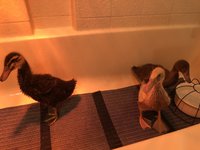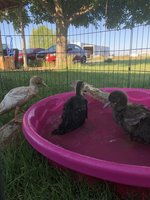katuswilsonii
Chirping
I am a new duck mom! I basically grew up in a barn so I am familiar with chickens and guinea hens but do not currently have any of my own. I have never owned ducks until now. I came across this website through various googlings of duck keeping topics.
I have three ducklings that I brought home from TSC four and a half weeks ago. They were about 3-5 days old when a I got them, so they are approximately 5 weeks old now. Maggie is a confirmed Pekin hen. She is the most bedraggled and least graceful of the group, kind of a hot mess to be honest, but she is definitely the most bold and the other two tend to follow her lead. The second is a suspected Rouen hen, tentatively named Gypsy unless it turns out to be a drake, in which case I will call him Rudy. Gypsy/Rudy is very reserved, often sitting quietly off to the side, just watching me, the others, the dogs or what have you. When given adequate time in deeper water though, he/she often gets a hair up their behind and goes balls crazy. Maggie is quacking nonstop when I am present, hence the confirmation of sex. G/R began making similar primitive quack sounds at the same time as Maggie, but has not progressed to the clear quack that Maggie has. Last but not least is Pretzel, a Khaki Campbell of unknown sex. Pretzel has not let out anything resembling a quack, but is very, very talkative. Save for Maggie getting pretty rowdy during feeding/cleaning activities, Pretzel is consistently the noisiest, and is constantly making noise even when I am not in view and is a total spaz. His/her noises are mostly still peeping sounds with an ever-increasing frequency of sounds resembling the post-peep but pre-quack sounds of the others, like a worn out squeaky-toy, with a peep-like pitch but isn’t actually a peep. I am leaning towards male, but I am not convinced based on the fact that he/she never shuts up!
I am a wildlife biology student at UC Davis due to complete my undergraduate degree this summer. After taking Biology and Ecology of Wild Birds last fall and Ecology and Management of Waterfowl and Game Birds this winter, it became clear I was not going to make it through another spring chick event at TSC without bringing home ducklings, ducks are just so damn cute. So here I am. Haha!
Fun and pontentially irritating fact about me: I am a total grammar/terminology nazi and a thing that drives me nuts is that people seem to refer to female ducks as ducks versus drakes for males. I do not understand this!!!! All ducks are ducks...that’s why they’re called ducks! Female ducks and literally all other female fowl (Anseriformes & Galliformes) are hens! LOL. So basically, some of ya’ll are making me crazy! Also, having spent my childhood doing farm things, a bean is the clay-like ball of gunk that develops in a male horse’s you-know-what! Such unpleasant images/memories come to mind every time I read “bean”! So if anyone is interested, the anatomical term for the tip of a duck’s bill is dertrum and is sometimes referred to as the nail.
Side bar (because it is waterfowl related *tehe*): The correct common name for Branta canadensis is Canada Goose. So next time you see “Canadian geese” you can impress your birder friends by referring to it by its proper common name. You are welcome.
So anyway, I want to add two additional ducks as soon as I get these guys moved to their currently under-construction coop. I am thinking a Cayuga male and the 5th of undecided breed/gender, pending the sexes of the Rouen and KC. I do not eat that many eggs, but my fiancé loves to bake. I plan to add chickens next spring, so I don’t need that many females, but being descendants of Mallards, I do not want more drakes than hens. Mallards are known for what we in the wildlife biz often refer to as “duck-rape” (gasp! Anthropomorphism!) where one or more males force copulation repeatedly with females and I have seen many females drowned/otherwise killed in the process.
Side bar 2: Oddly enough this behavior has led to a bizarre “arms race” of sorts between male and female Mallard genital morphology which I can tell you about if anyone is interested...
As many of you know, females are louder and generally more obnoxious than males, so for pets, males are obviously ideal, but I would like to avoid potential stress for my girlies. So we shall see!
If you read this far, I am impressed, I talk/type a lot and love facts and stories, hence why this went on for so long. So thanks for reading and I look forward to chatting with you all.
~Kat
I have three ducklings that I brought home from TSC four and a half weeks ago. They were about 3-5 days old when a I got them, so they are approximately 5 weeks old now. Maggie is a confirmed Pekin hen. She is the most bedraggled and least graceful of the group, kind of a hot mess to be honest, but she is definitely the most bold and the other two tend to follow her lead. The second is a suspected Rouen hen, tentatively named Gypsy unless it turns out to be a drake, in which case I will call him Rudy. Gypsy/Rudy is very reserved, often sitting quietly off to the side, just watching me, the others, the dogs or what have you. When given adequate time in deeper water though, he/she often gets a hair up their behind and goes balls crazy. Maggie is quacking nonstop when I am present, hence the confirmation of sex. G/R began making similar primitive quack sounds at the same time as Maggie, but has not progressed to the clear quack that Maggie has. Last but not least is Pretzel, a Khaki Campbell of unknown sex. Pretzel has not let out anything resembling a quack, but is very, very talkative. Save for Maggie getting pretty rowdy during feeding/cleaning activities, Pretzel is consistently the noisiest, and is constantly making noise even when I am not in view and is a total spaz. His/her noises are mostly still peeping sounds with an ever-increasing frequency of sounds resembling the post-peep but pre-quack sounds of the others, like a worn out squeaky-toy, with a peep-like pitch but isn’t actually a peep. I am leaning towards male, but I am not convinced based on the fact that he/she never shuts up!
I am a wildlife biology student at UC Davis due to complete my undergraduate degree this summer. After taking Biology and Ecology of Wild Birds last fall and Ecology and Management of Waterfowl and Game Birds this winter, it became clear I was not going to make it through another spring chick event at TSC without bringing home ducklings, ducks are just so damn cute. So here I am. Haha!
Fun and pontentially irritating fact about me: I am a total grammar/terminology nazi and a thing that drives me nuts is that people seem to refer to female ducks as ducks versus drakes for males. I do not understand this!!!! All ducks are ducks...that’s why they’re called ducks! Female ducks and literally all other female fowl (Anseriformes & Galliformes) are hens! LOL. So basically, some of ya’ll are making me crazy! Also, having spent my childhood doing farm things, a bean is the clay-like ball of gunk that develops in a male horse’s you-know-what! Such unpleasant images/memories come to mind every time I read “bean”! So if anyone is interested, the anatomical term for the tip of a duck’s bill is dertrum and is sometimes referred to as the nail.
Side bar (because it is waterfowl related *tehe*): The correct common name for Branta canadensis is Canada Goose. So next time you see “Canadian geese” you can impress your birder friends by referring to it by its proper common name. You are welcome.
So anyway, I want to add two additional ducks as soon as I get these guys moved to their currently under-construction coop. I am thinking a Cayuga male and the 5th of undecided breed/gender, pending the sexes of the Rouen and KC. I do not eat that many eggs, but my fiancé loves to bake. I plan to add chickens next spring, so I don’t need that many females, but being descendants of Mallards, I do not want more drakes than hens. Mallards are known for what we in the wildlife biz often refer to as “duck-rape” (gasp! Anthropomorphism!) where one or more males force copulation repeatedly with females and I have seen many females drowned/otherwise killed in the process.
Side bar 2: Oddly enough this behavior has led to a bizarre “arms race” of sorts between male and female Mallard genital morphology which I can tell you about if anyone is interested...
As many of you know, females are louder and generally more obnoxious than males, so for pets, males are obviously ideal, but I would like to avoid potential stress for my girlies. So we shall see!
If you read this far, I am impressed, I talk/type a lot and love facts and stories, hence why this went on for so long. So thanks for reading and I look forward to chatting with you all.
~Kat











 We are glad you joined our flock!
We are glad you joined our flock!
